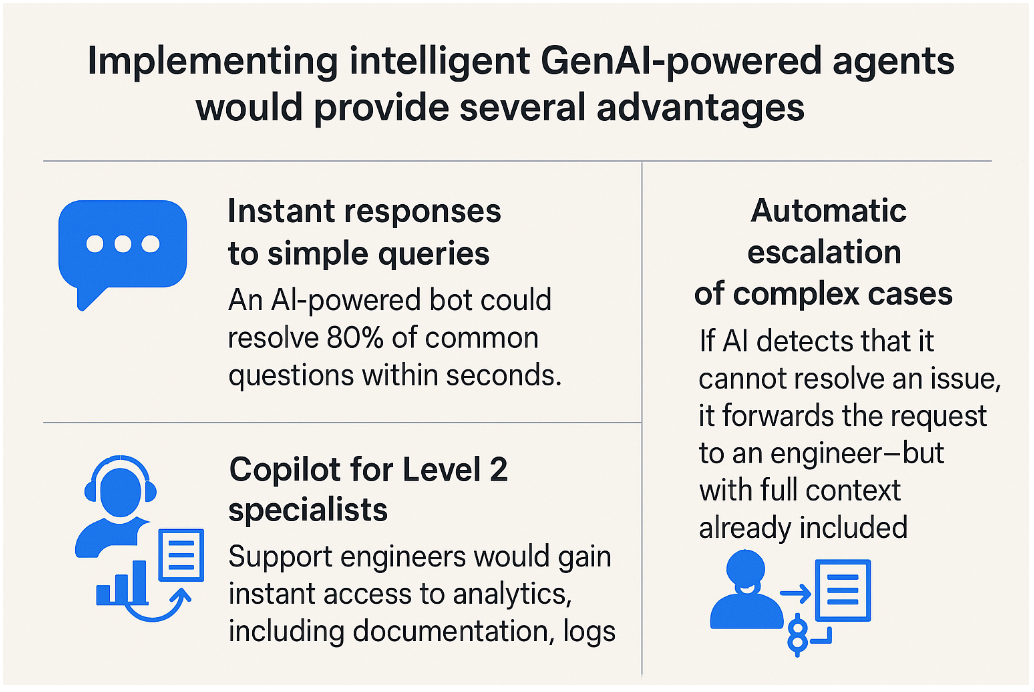Reimagine IT Support: How AIOps & GenAI Would Have Crushed Old IT Challenges

Senior Service Engineer

Reflecting on past projects, it’s clear that AIOps and GenAI could have significantly improved our efficiency, support team effectiveness, and customer service. We ask a bold question: What if we had AIOps and GenAI back then? This analysis explores how these technologies could have addressed past challenges and, more importantly, the strategic opportunities they offer for current and future projects. From stabilizing a national transport operator’s loyalty system, to managing the data flood in a Sales Tax platform, to untangling technical debt in a custom CRM/HRM system—we explore how AI could have turned firefighting into foresight.
We break down how automated ops, AI copilots, and intelligent insights would have made a measurable difference—and how they’re doing just that today. These stories aren’t just reflections—they’re roadmaps. If you’re exploring how to modernize and future-proof your operations, start here.
How We Stabilized a Nation’s Loyalty Transport Platform
One of our most critical engagements involved stabilizing and optimizing the loyalty system for a national transport operator. Upon project initiation, we identified significant operational challenges impacting service delivery:
- Frequent system failures that prevented customers from using the service.
- Low system availability, especially during peak hours.
- High support ticket volume and delayed response times—users were frustrated, and response times left much to be desired.
If we had a unified observability platform back then—integrating comprehensive data such as metrics, logs, traces, user experience analytics, and synthetic testing—we would have significantly enhanced our operational efficiency.
What key business benefits would this bring?
- Focus on outcomes, not tools. Instead of sifting through tons of data, we would instantly see whether users were experiencing issues or not.
- A proactive rather than reactive approach. Instead of learning about failures from customer complaints, we could have predicted and prevented them more often.
- Data accessibility for all. Not just engineers but also product managers, analysts, and customer support teams could access the necessary insights and make faster decisions.
This would have been a completely different level of system management and user service.
GenAI Shift for Transport Systems in 2025
1. Automated Incident Detection and Response
GenAI can analyze vast amounts of system data in real-time to detect anomalies and predict potential failures before they occur. By automating the detection and initial response processes, GenAI reduces downtime and minimizes the impact on customers. This proactive approach ensures higher system availability, especially during peak hours.
2. Intelligent Customer Support
Implementing GenAI-powered virtual assistants can handle a significant portion of customer inquiries, providing instant responses to common issues and freeing human agents to focus on more complex problems. This leads to faster resolution times and improved customer satisfaction.
3. Enhanced Data Analysis and Decision-Making
GenAI can process and analyze large datasets to identify patterns and trends that may not be immediately apparent to human analysts. This capability enables more informed decision-making regarding system maintenance, upgrades, and resource allocation, ultimately contributing to a more robust and reliable loyalty system.
4. Automated Script Generation for System Maintenance
Routine system maintenance tasks can be automated through scripts generated by GenAI, reducing the need for manual intervention and decreasing the likelihood of human error. This automation leads to more efficient operations and allows IT staff to focus on strategic initiatives.
5. Continuous Learning and Improvement
GenAI systems can learn from past incidents and user interactions to continuously improve their performance. Over time, this leads to more accurate predictions, better customer interactions, and a more resilient loyalty system.
By integrating GenAI solutions into the support strategy, the national transport operator can achieve a more proactive, efficient, and customer-centric approach to managing their loyalty system.
Optimizing High-Volume Tax Systems
Another interesting case was supporting the Sales Tax Online system, which processed massive volumes of data. The key operational challenges included:
- Concurrent User Activity: A large number of users were working with the system simultaneously.
- Information Overload: An excessive data stream surpassing conventional analytical capabilities.
- Rapid System Iteration: Requiring constant change monitoring.
Implementing the AIOps approach would have allowed us to:
- Automatically detect relationships between events, including hidden correlations.
- Aggregate incidents into logical clusters, revealing underlying patterns and facilitating efficient prioritization and resolution.
- Analyze historical data analysis to forecast potential issues, allowing for proactive mitigation and minimizing service disruptions.
But this is only part of the solution. The second key element would have been GenAI solutions.
How Could GenAI Improve User Support?
The contact center managed a substantial volume of daily inquiries, encompassing a spectrum of issues from routine queries to intricate challenges. This resulted in processing delays, impacting user satisfaction.
Implementing intelligent GenAI-powered virtual agents would provide significant operational benefits:
- Rapid Resolution of Routine Inquiries: Instant responses to simple queries. An AI-powered bot could resolve 80% of common questions within seconds.
- Automated Escalation of Complex Issues: If AI detects that it cannot resolve an issue, it forwards the request to an engineer—but with full context already included.
- Enhanced Support Engineer Productivity: Copilot for Level 2 specialists. Support engineers would gain instant access to analytics, including documentation, logs, and the system’s accumulated knowledge base.
These enhancements substantially decrease response times, improve support team efficiency, and elevate the overall user experience.

Modernizing a CRM/HRM Platform
Technical debt is a common issue for many companies, and in the “Unique CRM/HRM System” project, it became a serious challenge:
- Increased Code Complexity: As system functionality expanded, the codebase grew, and logic became more complex.
- System Fragility: Due to numerous dependencies, even a minor change could break the system.
- Resource-Intensive Modernization: Modernization required significant time and resources.
Historically, such projects were perceived as complex and difficult to resolve quickly. However, GenAI is changing the approach to modernization. This process may involve:
- Migrating to modern frameworks that provide greater functionality.
- Restructuring systems to improve modularity.
- Refactoring or rehosting applications to run in more cost-effective cloud environments.
However, the goal of modernization isn’t just rewriting as much code as possible—it’s about improving systems and processes so that businesses can generate more incredible value. This means leveraging GenAI to:
- Understand the existing codebase.
- Identify the core drivers of business value.
- Modernize only the essential systems and processes required for that value.
When applied and strategically implemented, GenAI can rapidly analyze legacy components—documentation, code, observability data, call logs, development patterns, and more—and distill them into simple, natural-language process descriptions.
This approach not only facilitates a deeper understanding for engineers but also empowers business stakeholders to define critical requirements. Consequently, business and engineering teams can collaborate more effectively, determining what to retain, upgrade, or retire, leading to more strategic and efficient modernization initiatives.
From Reactive to Proactive
The case studies discussed highlight the tangible benefits of these technologies in diverse scenarios, from stabilizing critical loyalty systems to managing high-volume data processing and addressing technical debt. Don’t wait for problems to arise. Anticipate them, prevent them, and create a seamless experience for your users. Start by assessing your current monitoring and support systems, identifying areas for improvement, and planning a phased approach to AIOps and GenAI integration. Contact our team for a free consultation to discuss how AIOps and GenAI can transform your support approach and drive tangible business outcomes.


